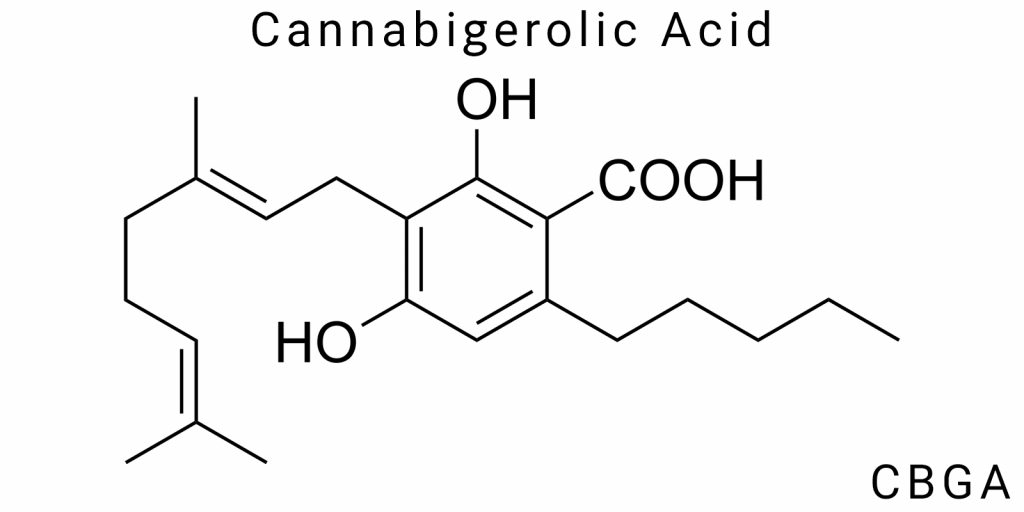Cannabigerolic acid (CBGA), as the primary precursor of many cannabinoids, is a molecule receiving significant attention in scientific research due to its unique biochemical properties and potential for medical application. CBGA plays a crucial role in cannabinoid metabolism, as it is the source compound for the synthesis of well-known substances such as cannabidiol (CBD), cannabinol (CBN), and tetrahydrocannabinol (THC), highlighting its importance not only from a biochemical perspective but also from a therapeutic standpoint. Considering the continuously growing interest in cannabinoids within the context of their use in medicine and pharmaceuticals, CBGA is at the center of research aimed at expanding the spectrum of medical indications and improving production methods for these compounds.
The biosynthesis of CBGA occurs in Cannabis plants through complex enzymatic reactions that lead to the formation of this molecule from cannabigerol (CBG) and its precursors. Since CBGA is the initial compound for the synthesis of other cannabinoids, its significance in the processes that determine the chemical structure of cannabis cannot be overstated. CBGA molecules possess important antioxidant and anti-inflammatory properties, indicating their potential in the treatment of numerous diseases such as neurodegenerative disorders, cardiovascular conditions, and in the fight against oncological processes.
In medical practice, the interest in CBGA is driven by its ability to interact with the body’s endocannabinoid system. Its role as part of a broad group of cannabinoids that may have therapeutic effects without psychoactive properties makes CBGA essential for research in the area of safe treatments for various diseases. Studying the mechanisms of action of CBGA and its pharmacological properties opens new horizons in the therapy of diseases such as Alzheimer’s, Parkinson’s, as well as in the treatment of various inflammatory processes.
Research on CBGA holds great significance not only from a medical perspective but also in terms of the economic and environmental aspects of production. Due to its role as a major precursor, CBGA can be effectively utilized in the industrial production of cannabinoids, which drives interest in developing new methods of its synthesis and improving the efficiency of cultivating plants rich in this cannabinoid. Genetic modifications and biotechnologies may ensure higher concentrations of CBGA in cannabis plants, allowing for significant reductions in production costs and minimizing environmental impact.
Definition and Chemical Structure of CBGA
Molecular Formula and Structure of CBGA
Cannabigerolic acid (CBGA) is a naturally occurring organic compound that serves as a primary precursor for many cannabinoids found in plants of the genus Cannabis. Its molecular formula is C₂₂H₃₀O₄, indicating the presence of 22 carbon atoms, 30 hydrogen atoms, and 4 oxygen atoms in the molecular structure. CBGA belongs to the group of cannabigerol-type acids and is classified as a carboxylic acid, playing a crucial role in the biosynthetic processes that occur in the tissues of the cannabis plant.
Structurally, CBGA consists of two main components: a polycyclic phenolic ring and a side chain containing a carboxyl group (-COOH), which characterizes it as an acid. The phenolic ring has two side substituents: one is isopropenyl and the other is benzyl. This structural composition enables CBGA to interact with various biological molecules, particularly with receptors of the endocannabinoid system. The CBGA structure can undergo rearrangements during biosynthesis to be converted into other cannabinoids, such as cannabidiol (CBD), tetrahydrocannabinol (THC), and cannabigerol (CBG).
The CBGA molecule also has characteristics that allow it to pass easily through biological membranes due to its hydrophobic nature in certain parts of the structure, facilitating its transport across cellular membranes, especially when transport mechanisms are involved. However, the carboxyl group, which is the terminal part of the molecule, imparts polarity and may be important for interactions with various biological molecules, including proteins and receptors.
Due to this structural feature, CBGA is a highly important molecule not only for the cannabinoid biosynthetic pathway but also for potential medical applications, particularly for the development of new pharmaceuticals. Its unique chemical properties enable it to interact with different targets in the human body.
Interaction of CBGA with Other Cannabinoids
CBGA is a crucial precursor for the synthesis of several key cannabinoids such as cannabidiol (CBD), tetrahydrocannabinol (THC), cannabinol (CBN), and cannabigerol (CBG), making it a vital compound in the cannabis biosynthetic process. The interaction of CBGA with other cannabinoids is not linear, and its role is defined by a series of enzymatic processes that are essential for the final properties of cannabinoids.
During the biosynthesis of cannabinoids in cannabis plants, CBGA functions as the primary precursor for the synthesis of cannabidiol (CBD) and tetrahydrocannabinol (THC). The process of converting CBGA into other cannabinoids depends on the type of enzyme involved in the reactions. For example, under the action of the enzyme cannabigerol synthase, CBGA is converted into cannabigerol (CBG), which is a foundational cannabinoid. Other enzymes such as cannabidiol synthase (CBDAS) and tetrahydrocannabinolic acid synthase (THCAS) are responsible for converting CBG into CBD or THC, respectively.
These conversions are critical for controlling the cannabinoid composition in different cannabis strains, which in turn may determine their therapeutic properties. For instance, elevated levels of CBD may offer important anti-inflammatory and neuroprotective effects, whereas high THC content may be beneficial for analgesic or psychoactive therapeutic purposes. Thus, the balance between different cannabinoids in the plant is determined not only by genetic factors but also by environmental conditions and cultivation technologies.
Because of this, CBGA serves as a core component in various cannabinoid synthesis pathways and plays a decisive role in the production of diverse bioactive molecules that may have therapeutic effects. This capability of CBGA provides a foundation for developing new methods of plant breeding and genetic modifications of cannabis aimed at increasing the concentrations of specific cannabinoids for medical use.
Chemical Properties of CBGA
CBGA is an organic acid with several important chemical properties that define its ability to interact with other molecules as well as its biological activity. Since the CBGA molecule contains a carboxyl group (-COOH), its chemical behavior is largely influenced by this functional element, which allows it to participate in reactions typical of acids. As an acid, CBGA can form salts with alkali metals or other complexes, which may influence its biological properties and activity.
Combined with the phenolic ring and the isopropenyl side chain that constitute other parts of the molecule, CBGA demonstrates significant chemical stability against oxidation and certain other chemical changes, allowing it to maintain its activity even under extreme conditions. In particular, its antioxidant properties may manifest in the reduction of oxidative stress, which is crucial for the treatment of inflammatory conditions and for mitigating the effects of free radicals on the body’s cells. This makes CBGA potentially useful in the therapy of neurodegenerative diseases such as Alzheimer’s and Parkinson’s.
CBGA also exhibits hydrophobic properties that allow it to dissolve easily in organic solvents and to penetrate biological membranes. Thanks to such characteristics, CBGA can effectively interact with endocannabinoid system receptors, especially CB1 and CB2 receptors, as well as with other molecular targets that may be important for its therapeutic effects.
These chemical properties define not only the biological activity of CBGA but also its potential in the development of new pharmaceutical agents, as many of these characteristics can be leveraged to create drugs with minimal side effects and high efficacy in treating various diseases.
Biosynthesis of CBGA in Plants
The biosynthesis of cannabigerolic acid (CBGA) in cannabis plants is a complex and multistep process that takes place within the plant cells. This process reflects the central role of CBGA in the overall cannabinoid biosynthetic pathway, as it serves as the primary precursor from which many other important cannabinoids are derived. CBGA biosynthesis occurs mainly in the tissues of organs such as the leaves, flowers, and stems of the cannabis plant. However, the highest concentration of CBGA is typically observed in the younger parts of the plant that are in a stage of active growth.
The process begins with the formation of molecules of olivetolic acid and geranyl pyrophosphate, which serve as the primary precursors of cannabinoids. These compounds undergo a series of biochemical reactions, including enzymatic transformations, that lead to the production of CBGA. The core of this process lies in the activity of specific enzymes capable of converting simple organic molecules into more complex cannabinoid structures. In the early stages of biosynthesis, polymers are produced within the cannabis plant cells, which subsequently react with other molecules to form cannabigerolic acid.
One of the key steps in the biosynthesis of CBGA is the formation of the cannabigerol (CBG) molecule using the enzyme cannabigerol synthase, which is further subjected to methylation or other transformations, depending on the desired cannabinoid form. This step is part of a broader metabolic pathway that includes numerous enzymatic stages facilitating the conversion of molecules into more complex bioactive compounds.
Also essential to this process is the involvement of metabolic pathways associated with monoterpene synthesis, which are integral to the cannabinoid molecular structure. Phytohormones, such as auxins, also significantly influence CBGA biosynthesis by stimulating the activity of certain enzymes and controlling the balance between the synthesis of cannabigerolic acid and other cannabinoids.
Pathways of CBGA Synthesis in Plants
The pathway of CBGA synthesis in cannabis plants can be conventionally divided into several primary stages. The initial stages involve the synthesis of terpene compounds such as geraniol and phytogeraniol, which are core components of the CBGA molecule. The formation of these compounds is facilitated by enzymes that catalyze the addition of carbon and hydrogen atoms to the molecular structure.
CBGA production begins with the synthesis of geranyl pyrophosphate, which acts as a precursor to cannabigerol (CBG). From this intermediate, cannabigerol undergoes several chemical transformations involving phytosynthetic enzymes that enable the conversion of this intermediate product into cannabigerolic acid (CBGA). This transformation process also includes the addition of carboxyl groups, which results in the formation of the acidic component.
A crucial stage in the synthesis of CBGA is the mechanism involving the binding of the CBG molecule with chlorophyll. This facilitates the stabilization of the molecule and allows it to proceed through the subsequent stages of biosynthetic transformations.
Role of CBGA in Cannabinoid Metabolism
CBGA is a central compound in the cannabinoid metabolic chain and plays an essential role in regulating biosynthetic processes. As CBGA serves as the primary precursor for many other cannabinoids, including CBD, THC, and CBG, its metabolism determines the balance among the various cannabinoid forms produced in cannabis plants. CBGA functions as a kind of central connecting link that interacts with numerous enzymes responsible for converting it into other molecules.
The metabolism of CBGA is not limited solely to the synthesis of cannabidiol and tetrahydrocannabinol. CBGA also participates in the formation of many other bioactive molecules with potential therapeutic applications for various diseases. Notably, it contributes to the production of cannabinol, cannabigerolone, and other cannabinoids that exhibit diverse pharmacological effects.
CBGA’s involvement in cannabinoid metabolism also includes its influence on the endocannabinoid system of the body, particularly on CB1 and CB2 receptors. This allows CBGA to interact with the organism and regulate a variety of physiological processes, including the reduction of inflammatory responses, mitigation of oxidative stress, and enhancement of neuroprotection.
Enzymes Responsible for CBGA Synthesis
CBGA synthesis in cannabis plants is facilitated by multiple enzymes that catalyze different stages of the molecular conversion from intermediates to final compounds. One of the primary enzymes responsible for CBGA synthesis is cannabigerol synthase (CBGS). This enzyme catalyzes the transformation of cannabigerol precursors into cannabigerolic acid, which is the fundamental compound from which other cannabinoids are subsequently synthesized.
Other enzymes that also play significant roles in this process include cannabidiol synthase (CBDAS) and tetrahydrocannabinolic acid synthase (THCAS), which are responsible for converting CBGA into their respective cannabinoids. These enzymes are crucial in regulating cannabinoid synthesis, as their activity determines which specific cannabinoid will predominate in the plant’s chemical profile.
Depending on genetic factors and environmental conditions, the activity of these enzymes may vary, leading to variations in the cannabinoid content among different cannabis strains.
Natural Sources of CBGA
Cannabigerolic acid (CBGA) is found in significant quantities in cannabis plants, especially in the younger parts of the plant, such as leaves and flowers. These tissues are the sites of the most active cannabinoid synthesis, and therefore the CBGA concentration is highest there. However, CBGA can also be detected in certain other natural sources, though its concentration in those is significantly lower.
In wild cannabis species, CBGA is primarily formed during stages of active growth when the plant accumulates the highest amounts of bioactive compounds. Meanwhile, in artificially cultivated plants subjected to selective breeding and genetic modification, there may be a marked increase in CBGA concentrations.
Pharmacological Properties of CBGA
Cannabigerolic acid (CBGA), one of the primary acidic forms of cannabigerol (CBG), is a precursor to many other important cannabinoids such as cannabidiol (CBD) and tetrahydrocannabinol (THC). This molecule plays an active role in cannabinoid biosynthetic pathways, thus attracting significant attention in the context of its pharmacological properties, particularly in the treatment of various pathologies. CBGA is not only a precursor to other cannabinoids but also demonstrates substantial pharmacological potential in its own right, especially due to its effects on the endocannabinoid system, antioxidant and anti-inflammatory properties, and its capacity for neuroprotection.
Through its ability to regulate various biological processes such as inflammation, oxidative stress, and nerve damage, CBGA opens new possibilities for treating numerous diseases, including neurological disorders, inflammatory conditions, and cardiovascular disturbances. Importantly, CBGA does not possess pronounced psychoactive effects like those of THC, making it more appealing for medical use, especially in contexts where safety and the absence of harmful side effects are crucial.
Impact on the Endocannabinoid System
The endocannabinoid system (ECS) is a vital component of biological regulation in both humans and animals. It includes CB1 and CB2 receptors, which are located in the brain, central nervous system, and peripheral organs such as the heart, gastrointestinal tract, and immune system. Endocannabinoids like anandamide act as natural ligands for these receptors, helping regulate various physiological processes, including pain perception, appetite, mood, and inflammation.
CBGA is capable of interacting with the endocannabinoid system through activation or modulation of these receptors. It is believed that CBGA exerts indirect activity toward CB1 and CB2 receptors and may also influence enzymes that regulate the levels of endogenous anandamide. This suggests that CBGA can elevate the levels of natural cannabinoids in the body, promoting ECS balance and alleviating symptoms such as anxiety, pain, and depression.
According to research, CBGA may promote the activation of CB2 receptors, which is particularly important in the context of immune system modulation. These receptors are densely expressed in peripheral organs such as the spleen and lymph nodes, and their activation can reduce inflammatory processes, which is beneficial in the treatment of autoimmune diseases and inflammatory disorders.
Antioxidant and Anti-Inflammatory Properties
One of the key aspects of CBGA’s pharmacological activity is its ability to reduce oxidative stress. Oxidative stress arises from the accumulation of free radicals and reactive oxygen species (ROS), which can damage cell membranes, proteins, and DNA, leading to the development of numerous chronic diseases, including cardiovascular diseases, neurodegenerative disorders, and cancer.
CBGA exhibits antioxidant activity that allows it to lower the levels of these harmful molecules. This is achieved through CBGA’s ability to neutralize free radicals and activate internal defense mechanisms of the body, including enzymes involved in the restoration of oxidized molecules. In this context, CBGA may become a valuable tool for the prevention and treatment of diseases associated with oxidative stress.
Regarding its anti-inflammatory properties, CBGA can inhibit the synthesis of pro-inflammatory molecules such as prostaglandins and cytokines, which cause or exacerbate inflammatory processes in the body. CBGA can reduce the levels of molecules like interleukin-6 (IL-6) and tumor necrosis factor-alpha (TNF-α), which are key modulators of inflammation. This opens the possibility for CBGA to be used in treating conditions accompanied by chronic inflammation, such as arthritis, gastrointestinal disorders, and others.
Moreover, CBGA’s anti-inflammatory effects allow it to reduce the infiltration of inflammatory cells into tissues, thereby decreasing the severity of inflammatory responses. This makes it effective in combating various types of diseases where inflammation is a primary pathogenic mechanism.
Effect on Neuroprotection and Potential in Treating Neurodegenerative Diseases
Neuroprotection is another significant pharmacological property of CBGA. Neurodegenerative diseases such as Alzheimer’s and Parkinson’s arise from damage and degeneration of neurons, leading to impaired function and cell death. Oxidative stress and inflammation play a key role in the development of these diseases, which is why CBGA’s antioxidant and anti-inflammatory properties are critically important for neuroprotection.
Studies have shown that CBGA may have a positive effect on protecting neurons from toxic influences. In particular, CBGA is capable of reducing the levels of beta-amyloid, a molecule that accumulates in the brain in Alzheimer’s disease and leads to the formation of plaques that are toxic to neurons. CBGA also demonstrates the ability to regulate the levels of neurotoxic molecules that emerge during neurodegeneration, helping maintain the structural and functional integrity of neurons.
These properties make CBGA a promising candidate for the development of therapeutic strategies in the treatment of complex diseases such as Alzheimer’s and Parkinson’s, where inflammation, oxidative stress, and toxic molecules play a central role in pathogenesis. Furthermore, CBGA may be beneficial in the context of traumatic brain injuries, where rapid neuronal recovery and inflammation reduction are critical to preventing further damage.
It is also worth noting that CBGA may assist in supporting neurogenesis-the process of generating new neurons in the adult brain. This makes it potentially useful in treating conditions such as depression and post-traumatic stress disorder (PTSD), where restoring normal neuronal function is vital for treatment and symptom relief.
The Impact of CBGA on Human Health
Cannabigerolic acid (CBGA), while primarily known as the precursor to important cannabinoids such as THC and CBD, possesses unique pharmacological properties that open new perspectives for the treatment of numerous diseases. In recent years, scientific research has focused on exploring the potential of CBGA to improve human health, particularly in the context of combating oncological, cardiovascular, inflammatory diseases, and neurological disorders. Considering its low level of psychoactivity, CBGA is becoming an attractive candidate for therapeutic application without the risk of developing adverse psychoactive effects.
Therapeutic Potential of CBGA in the Treatment of Various Diseases
CBGA demonstrates a number of beneficial effects that open perspectives for the treatment of a wide range of illnesses. Since cannabinoids interact with the endocannabinoid system, which is responsible for regulating physiological processes such as appetite, mood, pain, and inflammation, CBGA may be useful in managing these conditions. Furthermore, its antioxidant and anti-inflammatory properties make CBGA beneficial in the treatment of inflammatory diseases such as arthritis, chronic pain, and heart disease.
Cancer: Potential in Fighting Oncological Diseases
One of the most promising directions of research is the use of CBGA in oncology. Cancer is one of the biggest challenges for modern medicine, and the search for new means of combating this disease remains a priority for scientists. Research has shown that CBGA may be effective in reducing the spread of cancer cells due to its ability to decrease the proliferation rate of tumor cells and promote apoptosis (cell death). The interaction of CBGA with CB2 receptors, which are located on the surface of immune system cells, may activate processes that contribute to the destruction of tumor cells. Additionally, CBGA is capable of inhibiting angiogenesis-the process of forming new blood vessels necessary for tumor growth-thereby reducing their nourishment and growth.
Scientists also point to the potential of CBGA as adjuvant therapy in chemotherapy, as it may reduce the toxicity of chemotherapeutic agents, improve the overall condition of patients, and lessen the side effects of treatment such as nausea, fatigue, and pain. However, additional clinical trials are needed to confirm the effectiveness of CBGA in cancer treatment.
Cardiovascular Diseases
Cardiovascular diseases (CVD), including heart and vascular diseases, are one of the leading causes of mortality worldwide. Problems such as atherosclerosis, stroke, ischemic heart disease, and high cholesterol levels may be associated with vascular dysfunction and inflammatory processes in the body. CBGA, due to its antioxidant and anti-inflammatory properties, may help in preventing the development of such diseases.
One of the mechanisms of action of CBGA in the context of cardiovascular diseases is its ability to reduce oxidative stress, which is one of the main factors in the development of atherosclerosis. CBGA helps neutralize free radicals and contributes to the improvement of endothelial function in blood vessels, which is of significant importance for preventing the development of strokes and heart attacks. Furthermore, CBGA has the ability to reduce the level of LDL (low-density lipoproteins), which lead to the formation of atherosclerotic plaques, as well as increase the level of HDL (high-density lipoproteins), which help remove excess cholesterol from the body. This opens the potential for CBGA as an additional remedy in the treatment and prevention of cardiovascular diseases.
Other Chronic Diseases
CBGA has a wide range of beneficial properties that may be useful in the treatment of a number of chronic diseases such as autoimmune disorders, chronic pain, and neurological diseases. Due to its ability to modulate the immune system, CBGA may help in the treatment of diseases associated with immune cell imbalance, such as rheumatoid arthritis or systemic lupus erythematosus. CBGA may also be useful in treating chronic pain, as it reduces the level of inflammation and alleviates pain by regulating neurotransmission and decreasing sensitivity to pain.
Neurological diseases such as Alzheimer’s disease, Parkinson’s disease, and multiple sclerosis are also potential targets for treatment using CBGA. Its neuroprotective properties may help slow the progression of these diseases by reducing the level of oxidative stress in the brain and improving the function of neurons.
Mechanism of Action of CBGA in the Human Body
CBGA interacts with numerous molecular targets in the body, allowing it to influence a variety of physiological processes. One of the main mechanisms is its effect on the endocannabinoid system, which regulates essential body functions including pain, appetite, mood, immune response, and others. CBGA activates CB1 and CB2 receptors, which allows it to interact with the nervous and immune systems, as well as influence processes occurring in the cardiovascular and digestive systems.
Interaction with Cannabinoid Receptors
CBGA directly affects cannabinoid receptors CB1 and CB2. CB1 receptors are predominantly located in the central nervous system, while CB2 receptors are distributed in immune cells and peripheral organs. The interaction of CBGA with these receptors can modulate various processes in the body, from pain and inflammation control to the regulation of nervous functions and immune response.
Other Molecular Targets of CBGA
In addition to cannabinoid receptors, CBGA may interact with other molecular targets such as enzymes that regulate lipid and carbohydrate metabolism. This may assist in regulating energy processes in the body, particularly by reducing the level of inflammatory molecules and improving metabolic functions. There is also potential for CBGA to interact with serotonin and glutamate receptors, which provides the opportunity to use it in the treatment of depression, anxiety, and other mental disorders.
Technical and Environmental Aspects of CBGA Production
The process of producing cannabigerolic acid (CBGA) requires the integration of various technologies and approaches to achieve optimal results from both efficiency and environmental or economic standpoints. The complexity of CBGA production, particularly in laboratory and industrial conditions, lies in the high cost of raw materials, the necessity of precise control over synthesis and extraction conditions, and the environmental challenges associated with cannabis cultivation.
Methods of Obtaining CBGA in the Laboratory
The primary method of obtaining CBGA in the laboratory is extraction from cannabis plants. Extraction is conducted using organic solvents such as methanol, ethanol, or butane. In this process, plant materials are typically crushed and mixed with a solvent, allowing cannabinoids to be extracted from the plant tissues. The resulting mixture is then subjected to fractionation using various purification methods such as chromatography. The problem with such methods lies in the low efficiency of CBGA collection due to the low concentration of this compound in the plant tissues at later stages of development.
Extraction efficiency can be increased through the application of modern methods such as supercritical CO2 extraction, which allows for improved purity and yield of CBGA. However, this requires expensive equipment and meticulous process control, complicating the scalability of production. Additionally, CBGA extraction is often accompanied by the use of toxic solvents, which increases the demands for safety and environmental compliance in the production process.
Synthetic methods of obtaining CBGA are also actively developing. In such cases, chemical reactions such as methylation are used to convert CBG (cannabigerol) into CBGA. Synthetic methods can be significantly more economically efficient, as they reduce the need for large quantities of plant raw material, but they require high costs for chemical reagents and tight control over reaction conditions.
Genetic Modification of Plants to Increase CBGA Production
One of the most promising directions for increasing CBGA production is the genetic modification of cannabis plants. Using CRISPR-Cas9 technology and other gene-editing methods, the concentration of CBGA in plant tissues can be significantly increased. For example, by altering the expression of genes responsible for cannabinoid biosynthesis or intervening in the metabolic pathways of cannabigerol, the yield of CBGA can be enhanced. Such methods make it possible to cultivate plants that produce higher amounts of cannabigerolic acid, reducing the costs of raw materials and the time required for cultivation.
Specifically, breeding cannabis strains rich in CBGA will enable the acquisition of this compound in large quantities without the need for extensive agricultural land, which also holds significant environmental potential. However, such modifications may provoke ethical and legal controversies due to the use of genetically modified organisms.
Use of Biotechnology in CBGA Production
Biotechnologies have become a vital tool in the production of CBGA. The use of bioreactors for cultivating microorganisms such as yeast or bacteria capable of producing CBGA opens new horizons for cannabinoid production. Through genetic engineering, microorganisms can be modified to produce CBGA via biosynthetic pathways previously exclusive to plants. The biotechnological approach allows for the creation of more efficient and sustainable systems for cannabinoid production, as the process can be conducted under controlled conditions, reducing resource needs and environmental emissions.
These methods enable CBGA production using simple or low-cost microorganisms, decreasing the reliance on traditional agricultural practices such as irrigation, fertilization, and plant treatment. However, this technology requires significant investment during the development and scaling phases.
Environmental Advantages and Challenges in CBGA Production
One of the main advantages of biotechnological methods is their environmental sustainability. They can reduce the need for agricultural land, pesticides, and chemical fertilizers, which positively impacts the environment. Additionally, bioreactor technologies may be less resource-intensive in terms of water and energy, as these processes can be conducted under optimal, controlled conditions with minimal environmental risk.
Nevertheless, large-scale cannabis cultivation still requires substantial land resources, which can lead to deforestation or soil depletion if sustainable farming principles are not adhered to. To avoid environmental damage, it is important to implement appropriate regulations that help preserve biodiversity and prevent ecosystem degradation.
Another important aspect is that some CBGA extraction processes, particularly those involving organic solvents or chemical reagents, can be toxic to the environment if not properly disposed of. Enhancing the environmental sustainability of CBGA production requires the adoption of technologies that minimize environmental impact, such as zero-waste technologies, waste recycling, and the use of safer solvents.
Barriers and Prospects for the Use of CBGA in Medical Practice
Cannabigerolic acid (CBGA) is an important compound in the context of the therapeutic potential of cannabinoids; however, the introduction of CBGA into medical practice faces numerous barriers, including legal and regulatory, as well as economic and social obstacles. Additionally, there are challenges related to scientific aspects, the need for further research, and the development of new technologies for producing this compound on an industrial scale. Considering these aspects is crucial for the further development of CBGA-based medical drugs and for ensuring patient access to such treatments.
Legal and Regulatory Issues
One of the major obstacles to the use of CBGA in medical practice is its legal and regulatory status. Although CBGA is a non-psychoactive cannabinoid and has no identified narcotic properties, the legal framework surrounding cannabis and its derivatives remains ambiguous in many countries. In several jurisdictions, cannabis and its components fall under strict regulations that complicate clinical trials and the certification of new pharmaceuticals. Some countries allow the use of cannabinoids only for a limited range of indications, while others refuse to recognize cannabis as a medicinal agent.
Specifically, CBGA is characterized by a lack of clear regulations permitting its use in the pharmaceutical sector. Most countries have not yet developed a unified international legal framework that would allow clinical research and the release of CBGA-based products. As a result, pharmaceutical companies cannot invest significantly in the development of cannabinoid-based medicines because it remains a legally risky endeavor. Moreover, the existence of differing certification and quality control standards for pharmaceuticals across countries complicates the globalization of the cannabinoid market.
The legal status of CBGA also depends on its classification: in many countries, cannabis-derived components may be categorized as “controlled substances.” This means that any use of this compound for medical purposes will require strict inspections, special licensing, and additional certifications. Furthermore, in countries where cannabis legalization is restricted, questions must be resolved regarding whether CBGA will be available through medical prescriptions or within the scope of medical cannabis programs.
Economic Barriers and Manufacturing Challenges
Economic barriers related to CBGA production present another significant issue for the medical application of this compound. The main difficulty lies in the fact that CBGA naturally occurs in cannabis plants only in very small concentrations, requiring substantial expenditures on raw materials and extraction processes. The issue is further complicated by high costs associated with cannabis cultivation as well as the technological infrastructure needed for CBGA extraction and purification.
Another factor is the challenge of producing large quantities of CBGA for pharmaceutical purposes. Unlike synthetic methods where reaction conditions can be manipulated to yield the desired amount of compound, plant-based extraction is limited in output. Synthetic production pathways can significantly reduce raw material costs, but they are also associated with high expenses for process development and optimization.
An additional economic barrier is the instability of demand for CBGA as a medical product. Since cannabinoids, including CBGA, are still in the early stages of research, pharmaceutical companies must carefully evaluate the risks of investing in drug development based on this compound. Due to the uncertainty surrounding the efficacy and safety of CBGA for treating various diseases, many companies refrain from mass-producing such products.
Potential Social Implications
The use of CBGA for medical purposes also carries several social implications. First and foremost, it is important to note that although therapeutic application of cannabinoids does not involve psychoactive effects, it may still provoke public concern, particularly in the context of legal prohibitions on cannabis. Fears that cannabinoids may contribute to the spread of illegal drugs can have serious social consequences, especially regarding public attitudes toward cannabis-based treatments.
Another potential social aspect is the accessibility of treatment. Since CBGA and its derivatives may be expensive to produce, their availability to broad segments of the population could be limited. The high cost of CBGA-based medications could render them inaccessible to patients with limited financial resources, creating inequality in access to therapeutic agents.
With the growing popularity of cannabinoids for treating various diseases, there is also the risk of CBGA being used in unauthorized and uncontrolled environments. Patients may use CBGA-based products without proper medical supervision, potentially leading to unexpected effects or interactions with other medications.
Prospects for the Use of CBGA in the Pharmaceutical Industry
Cannabigerolic acid (CBGA), as the precursor molecule to most cannabinoids, holds immense potential in the pharmaceutical field. This compound is characterized by unique pharmacological properties that open numerous opportunities for the development of new medications, as well as for enhancing existing therapeutic strategies. Due to its ability to interact with numerous biological targets, CBGA can serve as a foundation for therapeutic molecules in the treatment of a wide range of diseases, including neurodegenerative disorders, cardiovascular diseases, chronic pain, and other serious conditions.
The Potential of CBGA as a Basis for New Medications
One of the main areas of CBGA application lies in its use as a basis for developing new pharmaceutical drugs, particularly in the context of treating diseases such as cancer, chronic inflammatory conditions, and neurodegenerative disorders. The CBGA molecule interacts with numerous receptors and molecular targets, making it suitable for regulating various physiological processes. This enables the creation of drugs with new mechanisms of action that can operate more precisely and effectively while minimizing the side effects commonly associated with traditional therapies.
CBGA has numerous properties that may be beneficial in treating inflammatory and autoimmune diseases. Its ability to reduce oxidative stress and decrease levels of inflammatory markers makes it a promising candidate for the treatment of conditions such as arthritis, asthma, Crohn’s disease, and other chronic inflammatory illnesses. These properties of CBGA could be used to create drugs that not only reduce inflammation but also stimulate tissue regeneration, which is particularly important for chronic diseases.
CBGA also shows potential in neuroprotection, which could be useful in treating neurodegenerative diseases such as Parkinson’s disease and Alzheimer’s disease. Specifically, CBGA is capable of decreasing oxidative stress, lowering inflammation levels in the nervous system, and improving cognitive functions. In conditions such as Alzheimer’s, where key factors include disrupted neurotransmitter metabolism and the accumulation of toxic proteins, CBGA may improve neuronal function and reduce the toxic impact of proteins like β-amyloid.
Another important direction is the use of CBGA in oncology. Preliminary studies have shown that CBGA can inhibit the growth of tumor cells by influencing signaling pathways that regulate proliferation and apoptosis. When combined with traditional cancer treatment methods such as chemotherapy or radiotherapy, CBGA may enhance their effectiveness, reduce side effects, and increase their specificity.
Integration of CBGA into Existing Pharmaceutical Medications
Another important aspect is the possibility of integrating CBGA into already existing pharmaceutical drugs. This may include the use of CBGA to enhance the effects of medications intended to treat inflammation, pain, or chronic diseases. For instance, CBGA could be added to medications used for the treatment of arthritis or other inflammatory disorders, as CBGA is capable of reducing levels of inflammatory markers and oxidative stress.
The combination of CBGA with other cannabinoids, such as CBD or THC, also holds great potential. Due to its ability to interact with various receptors in the body, CBGA may enhance the effects of other cannabinoids, creating a synergistic effect. This allows for the development of drugs with higher efficacy at lower doses of active ingredients, which is an important factor in reducing the risk of side effects.
Integrating CBGA into existing drugs can also facilitate the adaptation of new therapeutic approaches to wide categories of patients, since such medications already have standardized dosages and proven efficacy. Given that CBGA is the natural precursor of most cannabinoids, this also reduces the costs associated with developing new medications that may have similar properties but require complex synthesis technologies.
Thus, the integration of CBGA into existing therapeutic strategies holds great potential, as it allows not only for improved treatment effectiveness but also for increased accessibility of medications to patients, especially those in need of long-term or comprehensive care. This also reduces the costs of developing new drugs, as existing infrastructure and production technologies can be used.
The prospects for developing new therapeutic approaches based on CBGA are driven by many factors. Most importantly, this cannabinoid opens new horizons for the treatment of diseases that are traditionally difficult to manage, such as neurodegenerative disorders or cancer. Additionally, its ability to interact with numerous molecular targets makes CBGA a potentially universal compound for the development of new pharmaceutical products.
Conclusion
Cannabigerolic acid (CBGA) is a key precursor to many cannabinoids that play a vital role in pharmacology and medical practice. Its unique properties, including its ability to regulate inflammation, reduce oxidative stress, and exert neuroprotective effects, open numerous possibilities for the development of new therapeutic strategies. As CBGA can interact with various biological targets, it demonstrates strong potential in the treatment of complex diseases such as cancer, neurodegenerative disorders, chronic pain, and inflammatory conditions.
The process of CBGA biosynthesis in plants and the possibility of its artificial production offer prospects for utilizing this compound as an innovative component in pharmaceutical preparations. Technical and biotechnological advancements in CBGA production, including plant genetic modifications and improved synthesis methods, can contribute to increasing its availability and effectiveness in medical applications.
However, despite these promising prospects, significant barriers remain to the widespread use of CBGA in medicine. These include legal and regulatory issues, economic challenges, and social implications that require further research and harmonization at the international level. The potential integration of CBGA into existing pharmaceutical drugs, as well as the development of new medications based on it, opens new horizons for the treatment of complex diseases that were previously difficult to manage.
In summary, CBGA possesses tremendous potential as a foundation for the creation of innovative drugs that could reshape current approaches to the treatment of several serious conditions. However, realizing this potential requires overcoming specific technical, economic, and social barriers. Future research aimed at thoroughly exploring the mechanisms of CBGA action and its interactions with other biological targets will undoubtedly form the basis for the development of new therapeutic strategies and improved access to effective medications for patients worldwide.
Sources:
- National Center for Biotechnology Information (NCBI)
PubMed Central (PMC) – Archive of biomedical scientific articles. https://www.ncbi.nlm.nih.gov/pmc/ - National Institutes of Health (NIH)
U.S. federal agency responsible for biomedical research. https://www.nih.gov/ - Nature Biotechnology
A leading scientific publication covering biotechnology and pharmaceutical innovation. https://www.nature.com/nbt/ - Journal of Medicinal Chemistry
A high-quality journal publishing scientific articles on drug chemistry, including cannabinoids and their therapeutic properties. https://pubs.acs.org/journal/jmcmar - Frontiers in Pharmacology
An open-access scientific journal publishing research in pharmacology, including cutting-edge findings in cannabinoid studies. https://www.frontiersin.org/journals/pharmacology - American Society for Pharmacology and Experimental Therapeutics (ASPET)
Scientific society that publishes “Molecular Pharmacology,” featuring articles on new molecules and drug mechanisms. https://www.aspet.org/ - The Journal of Clinical Investigation
A leading clinical research journal that publishes articles on novel therapeutic strategies, including the pharmacological effects of cannabinoids. https://www.jci.org/






